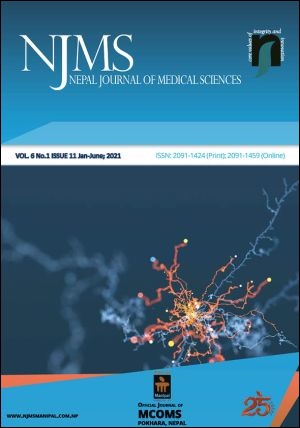Advanced Maternal Age and Pregnancy Outcome at Manipal Teaching Hospital: Cross-sectional Analytical study
DOI:
https://doi.org/10.3126/njms.v6i1.36728Keywords:
Advanced, Age, Perinatal, OutcomeAbstract
Introduction: Advanced and very advanced maternal age are associated with several adverse maternal and fetal outcome. The objective of this study was to find out the possible association between advance maternal age and adverse pregnancy outcomes at Manipal Teaching Hospital.
Methods: A cross sectional analytical study conducted at department of Obstetrics and Gynecology, Manipal Teaching Hospital, Pokhara, Nepal. A total of 198 patient who were ≥30 years and >24 weeks pregnant admitted in obstetric ward were selected. These patient were divided into three groups according to their age (30-34, 35-39 and ≥ 40years). We compared the incidence of adverse maternal and perinatal outcome among these groups. We also calculated odds ratio of maternal and perinatal outcomes in 35-39 years and ≥ 40years women, compared with women aged 30-34 years.
Results: Comparison of the three age groups revealed that advanced maternal age constitute a predisposing factor for malpresentation, gestational diabetes mellitus, placenta previa, fetal distress and caesarean section. Whereas, risk of non progress of labour, preterm birth, postpartum hemorrhage, perinatal death and congenital anomalies were increased in very advanced maternal age group. From these, statistical significance was reached in case of greater risk of malpresentation (p=0.01,OR=6.66), fetal distress (p=0.04, OR=2.6) and caesarean section(p=0.02,OR=2.06) in advanced age group when compared to the patients aged 30-34. Furthermore, very advanced age group were higher risk of postpartum hemorrhage (p=0.03, OR=2.47) and congenital anomalies, which were statistically significant (p=0.04, OR=29.57) when compared to the 30-34 years.
Conclusion: Advanced and very advanced maternal age is associated with several adverse maternal and perinatal outcome. The risk of perinatal complication begin to increase after the age of 35 but significantly increased after 40 years.
Downloads
Downloads
Published
How to Cite
Issue
Section
License
Copyright © by Nepal Journal of Medical Sciences. The ideas and opinions expressed by authors of articles summarized, quoted, or published in full text in this Journal represents only opinions of authors and do not necessarily reflect the official policy of Nepal Journal of Medical Sciences or the institute with which the author(s) is (are) affiliated, unless so specified.




